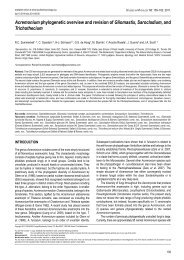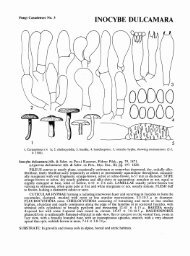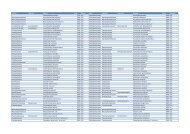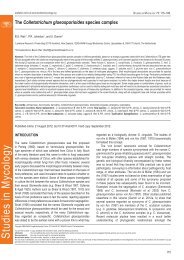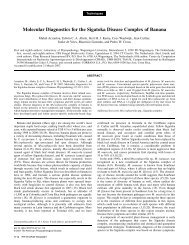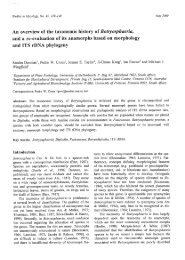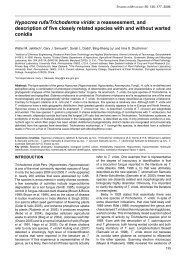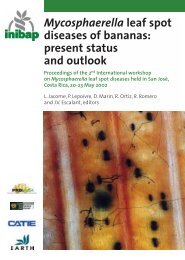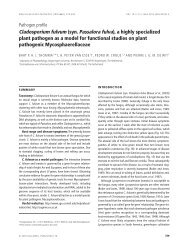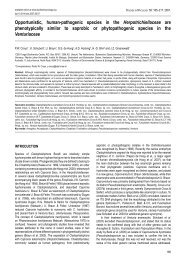Phylogenetic lineages in the Capnodiales - Cbs - KNAW
Phylogenetic lineages in the Capnodiales - Cbs - KNAW
Phylogenetic lineages in the Capnodiales - Cbs - KNAW
Create successful ePaper yourself
Turn your PDF publications into a flip-book with our unique Google optimized e-Paper software.
showed Phaeophleospora to reside <strong>in</strong> <strong>the</strong> Mycosphaerellaceae and<br />
Kirramyces <strong>in</strong> <strong>the</strong> Teratosphaeriaceae, respectively. However, most<br />
taxa <strong>in</strong>vestigated to date were collected from Eucalyptus. As shown<br />
<strong>in</strong> <strong>the</strong> present study, Phaeophleospora atk<strong>in</strong>sonii, a pathogen of<br />
Hebes spp. (Wu et al. 1996, Pennycook & McKenzie 2002), clusters<br />
distant from Phaeophleospora s. str., while <strong>the</strong> same is true for<br />
Phaeophleospora concentrica, which is a pathogen of Protea spp.<br />
(Taylor et al. 2001a), and Phaeophleospora stonei, a pathogen of<br />
Eucalyptus (Crous et al. 2007c, 2009c). These taxa thus clearly<br />
represent yet ano<strong>the</strong>r two genera <strong>in</strong> <strong>the</strong> Phaeophleospora complex.<br />
An older name that would potentially be available is Scoleciasis.<br />
However, when B. Sutton exam<strong>in</strong>ed exsiccati of <strong>the</strong> type species,<br />
S. aquatica, only ascomata of a Leptosphaeria species were<br />
found (Crous et al. 1997). The association of S. aquatica with <strong>the</strong><br />
Leptosphaeria was also noted <strong>in</strong> <strong>the</strong> orig<strong>in</strong>al description, and this may<br />
<strong>in</strong>dicate that Scoleciasis is allied to taxa <strong>in</strong> <strong>the</strong> Phaeosphaeriopsis/<br />
Phaeoseptoria complex (Arzanlou & Crous 2006). Both P. atk<strong>in</strong>sonii<br />
and P. concentrica have a typical Kirramyces morphology, namely<br />
brown, percurrently proliferat<strong>in</strong>g conidiogenous cells, and brown,<br />
obclavate, verruculose, transversely euseptate conidia. Fur<strong>the</strong>r<br />
species thus need to be <strong>in</strong>cluded <strong>in</strong> analyses before <strong>the</strong>se generic<br />
concepts can be clarified.<br />
Dur<strong>in</strong>g <strong>the</strong> course of this study several fresh collections of<br />
Leptosphaeria protearum were obta<strong>in</strong>ed. Leptosphaeria protearum<br />
is a major leaf spot and blight pathogen of Protea spp. (Knox-<br />
Davies et al. 1987), and causes severe losses <strong>in</strong> plantations of<br />
South African Protea spp. <strong>in</strong> Hawaii, and has been recorded <strong>in</strong><br />
many countries where South African proteas are cultivated (Taylor<br />
& Crous 1998, Taylor et al. 2001b, Crous et al. 2004a). Cultures<br />
of this pathogen were found to cluster <strong>in</strong> <strong>the</strong> Mycosphaerellaceae,<br />
where <strong>the</strong>y represent an undescribed genus, characterised<br />
by hav<strong>in</strong>g bitunicate asci without pseudoparaphyses, brown,<br />
3-septate ascospores, and a Coniothyrium-like anamorph. Its close<br />
phylogenetic relationship to Phaeophloeospora concentrica (Fig. 1)<br />
suggests that <strong>the</strong>y could be congeneric, and that <strong>in</strong> future more<br />
Phaeophloeospora-like anamorphs may be found to cluster <strong>in</strong> this<br />
clade. We propose a new genus to accommodate Leptosphaeria<br />
protearum below.<br />
Brunneosphaerella Crous, gen. nov. MycoBank MB514694.<br />
Etymology: Brunneus + Sphaerella = is after its brown ascospores<br />
and Sphaerella-like morphology.<br />
Mycosphaerellae similis, sed ascosporis brunneis, 3-septatis.<br />
Ascomata amphigenous, immersed to semi-immersed, black,<br />
s<strong>in</strong>gle, gregarious, substomatal, pyriform or globose with a papillate,<br />
periphysate ostiole. Peridium consist<strong>in</strong>g of three strata of slightly<br />
compressed textura angularis, an outer stratum of dark brown, thickwalled<br />
cells, becom<strong>in</strong>g paler <strong>in</strong> <strong>the</strong> central stratum, and hyal<strong>in</strong>e,<br />
th<strong>in</strong>-walled <strong>in</strong> <strong>the</strong> <strong>in</strong>ner stratum. Asci clavate to cyl<strong>in</strong>dro-clavate,<br />
often curved, taper<strong>in</strong>g to a pedicel, narrow<strong>in</strong>g slightly to a rounded<br />
apex with an <strong>in</strong>dist<strong>in</strong>ct ocular chamber, 8-spored, bitunicate with<br />
fissitunicate dehiscense. Pseudoparaphyses absent. Ascospores<br />
biseriate, fusiform, broader at <strong>the</strong> apical end, <strong>in</strong>itially hyal<strong>in</strong>e and<br />
1-septate, becom<strong>in</strong>g yellow-brown and 3-septate at maturity,<br />
slightly constricted at median to supra-median septum.<br />
Type species: Brunneosphaerella protearum (Syd. & P. Syd.) Crous,<br />
comb. nov.<br />
www.studies<strong>in</strong>mycology.org<br />
<strong>Phylogenetic</strong> l<strong>in</strong>eageS <strong>in</strong> <strong>the</strong> <strong>Capnodiales</strong><br />
Brunneosphaerella jonkershoekensis (Mar<strong>in</strong>c., M.J.<br />
W<strong>in</strong>gf. & Crous) Crous, comb. nov. MycoBank MB514695.<br />
Fig. 3.<br />
Basionym: Leptosphaeria jonkershoekensis Mar<strong>in</strong>c., M.J. W<strong>in</strong>gf. &<br />
Crous, In: Mar<strong>in</strong>cowitz et al., Microfungi occurr<strong>in</strong>g on Proteaceae <strong>in</strong><br />
<strong>the</strong> fynbos: 62. 2008.<br />
Ascomata pseudo<strong>the</strong>cial, subepidermal, immersed, obpyriform,<br />
papillate, 180–205 × 160–235 µm. Peridium 20–30 µm thick,<br />
composed of relatively large cells, 11–15 × 2.5–5.5 µm; cells<br />
arranged <strong>in</strong> three strata; outer stratum consist<strong>in</strong>g of 3–5 layers of dark<br />
brown, very thick-walled cells; middle stratum transient, consist<strong>in</strong>g<br />
of a few layers of pale brown, thick-walled, compressed cells; <strong>in</strong>ner<br />
stratum consist<strong>in</strong>g of 1–2 layers of th<strong>in</strong>-walled, very compressed<br />
cells. Pseudoparaphyses absent. Asci bitunicate, <strong>in</strong>flated cyl<strong>in</strong>drical<br />
to clavate, 81–95 × 13–15 µm, ocular chamber dome-shaped,<br />
<strong>in</strong>dist<strong>in</strong>ct. Ascospores pale brown, fusoid to ellipsoidal, taper<strong>in</strong>g<br />
towards <strong>the</strong> base, (25–)29–34(–36) × (5–)6–7(–9) µm (av. 31.4 ×<br />
6.7 µm), apical cell <strong>the</strong> shortest, upper hemispore slightly larger<br />
than lower, at times slightly curved, 3-septate, smooth, guttulate<br />
(adapted from Mar<strong>in</strong>cowitz et al. 2008).<br />
Host range and geographic distribution: Protea repens (South<br />
Africa, Western Cape) (Mar<strong>in</strong>cowitz et al. 2008).<br />
Specimen exam<strong>in</strong>ed: south Africa, Western Cape Prov<strong>in</strong>ce, Jonkershoek Nature<br />
Reserve, leaf litter of Protea repens, 6 Jun. 2000, S. Mar<strong>in</strong>cowitz, PREM 59447<br />
holotype.<br />
Notes: Although no culture is presently available for this species, it<br />
clearly represents a species of Brunneosphaerella, characterised<br />
by its bitunicate asci, and brown, 3-septate ascospores, as<br />
well as <strong>the</strong> absence of pseudoparaphyses. Brunneosphaerella<br />
jonkershoekensis can easily be dist<strong>in</strong>guished from B. protearum<br />
based on its much larger ascospores (Crous et al. 2004a).<br />
Brunneosphaerella protearum (Syd. & P. Syd.) Crous,<br />
comb. nov. MycoBank MB514696. Fig. 4.<br />
Basionym: Leptosphaeria protearum Syd. & P. Syd., Ann. Mycol.<br />
10: 441. 1912.<br />
Anamorph: “Coniothyrium” protearum Joanne E. Taylor & Crous,<br />
IMI Descriptions of Fungi and Bacteria No. 1343. 1998.<br />
Leaf spots circular to irregular, discrete to confluent, variable <strong>in</strong> size,<br />
under conditions favourable to disease symptoms more similar<br />
to a blight than a leaf spot, necrotic, sunken with a raised dark<br />
brown marg<strong>in</strong> and with conspicuous black ascomata <strong>in</strong> <strong>the</strong> dead<br />
tissue, 4–30 mm diam. Ascomata pseudo<strong>the</strong>cial, substomatal,<br />
amphigenous, immersed to semi-immersed, not erumpent, black,<br />
s<strong>in</strong>gle, gregarious, 180–320 µm diam; <strong>in</strong> section, substomatal,<br />
subepidermal, pyriform or globose with a papillate, periphysate<br />
ostiole, immersed <strong>in</strong> a stroma consist<strong>in</strong>g of deteriorated host<br />
mesophyll cells filled with fungal hyphae, (210–)230–264(–288) µm<br />
high, (180–)200–255(–300) µm diam. Peridium consist<strong>in</strong>g of three<br />
strata of slightly compressed textura angularis, an outer stratum of<br />
dark brown, thick-walled cells, becom<strong>in</strong>g paler <strong>in</strong> <strong>the</strong> central stratum,<br />
and hyal<strong>in</strong>e, th<strong>in</strong>-walled <strong>in</strong> <strong>the</strong> <strong>in</strong>ner stratum, altoge<strong>the</strong>r (20–)24.5–<br />
37.5(–50) µm thick. Asci clavate to cyl<strong>in</strong>dro-clavate, often curved,<br />
taper<strong>in</strong>g to a pedicel, narrow<strong>in</strong>g slightly to a rounded apex with an<br />
<strong>in</strong>dist<strong>in</strong>ct ocular chamber, 8-spored, bitunicate with fissitunicate<br />
dehiscense, (70–)80–87.5(–105) × (13.5–)14.5–16(–21.5) µm.<br />
Pseudoparaphyses absent. Ascospores biseriate, fusiform, broader<br />
31




